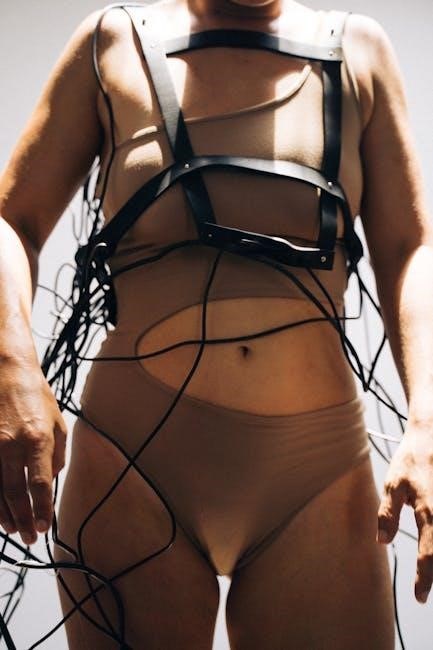The spine, a complex structure of 33 vertebrae, provides stability, flexibility, and protection for the spinal cord. Understanding its anatomy is crucial for diagnosing spinal disorders and injuries, offering insights into modern treatment concepts and surgical innovations.
1.1 Overview of the Spinal Column
The spinal column, also known as the vertebral column, is a complex structure composed of 33 vertebrae, including the sacrum and coccyx. It is divided into five regions: cervical, thoracic, lumbar, sacrum, and coccyx. The vertebrae are stacked on top of each other, separated by intervertebral discs that provide cushioning and flexibility. The spinal canal, formed by the vertebrae, houses the spinal cord, while neural foramina allow nerves to exit the spinal column. This structure supports the body’s weight, facilitates movement, and protects the spinal cord. Understanding the spinal column’s anatomy is essential for diagnosing and treating spinal disorders, as highlighted in modern resources like “Spinal Anatomy: Modern Concepts.”
1.2 Importance of Spinal Anatomy in Modern Medicine
Spinal anatomy is fundamental in modern medicine, particularly in diagnosing and treating spinal disorders like stenosis, herniated discs, and degenerative conditions. A detailed understanding of the spine’s structure aids surgeons in performing precise interventions, such as spinal fusion and disc replacement. Advances in imaging techniques enable better visualization of the spinal cord and nerves, improving diagnostic accuracy. This knowledge also informs rehabilitation strategies, helping patients regain mobility and strength. Resources like “Spinal Anatomy: Modern Concepts” provide comprehensive insights, making them invaluable for medical professionals and students. By grasping spinal anatomy, healthcare providers can deliver more effective care, addressing both common and complex spinal issues with enhanced precision and innovation.

Structure of the Spine
The spine consists of 33 vertebrae, intervertebral discs, and fused sections like the sacrum and coccyx, forming a flexible yet protective framework for the spinal cord.
2.1 Regions of the Spine
The spine is divided into five distinct regions, each serving specific functions. The cervical region, located in the neck, supports the head and allows extensive mobility. The thoracic region, situated in the upper back, connects to the rib cage, enhancing stability and protection for internal organs. The lumbar region, in the lower back, bears significant body weight and facilitates lifting and bending. The sacrum, a fused set of vertebrae, forms the pelvis base, while the coccyx, or tailbone, provides additional support and balance. Each region’s unique structure contributes to the spine’s overall functionality, ensuring a balance of strength, flexibility, and protection for the spinal cord and nerves.
2.2 Cervical, Thoracic, and Lumbar Vertebrae
Cervical vertebrae, found in the neck, are the smallest and most flexible, with seven vertebrae (C1-C7) designed to support the head’s weight and allow wide-ranging motion. Thoracic vertebrae (T1-T12) are larger and more robust, connecting to the rib cage to protect vital organs while maintaining stability. Lumbar vertebrae (L1-L5) are the largest, designed to bear significant body weight and facilitate movements like lifting and bending. Each type of vertebrae has distinct anatomical features, such as cervical vertebrae’s foramen transversarium, thoracic’s articulation with ribs, and lumbar’s robust structure for load-bearing. These differences reflect their specialized roles in spinal function and overall body mechanics.
2.3 Sacrum and Coccyx
The sacrum and coccyx are the lowest portions of the vertebral column. The sacrum, a fused set of five vertebrae, forms the base of the pelvis and connects to the lumbar spine. It plays a crucial role in weight distribution and supports the pelvic organs. The coccyx, or tailbone, is a small, flexible structure at the spine’s end, composed of four fused vertebrae. It provides attachment points for muscles and ligaments, aiding in bowel and bladder control. Both structures are essential for maintaining spinal stability and facilitating movement. Their unique anatomy ensures protection of the spinal cord’s lower nerves while supporting the body’s posture and functional needs.

Key Components of the Spine
The spine comprises vertebrae, intervertebral discs, the spinal cord, and neural foramina. Vertebrae provide structural support and protection, while discs enable flexibility. The spinal cord transmits nerve signals, and neural foramina allow nerve passage.
3.1 Vertebrae and Their Functions
Vertebrae are the building blocks of the spine, providing structural support and protection for the spinal cord. Each vertebra is designed to bear weight, facilitate movement, and maintain posture. The cervical, thoracic, and lumbar vertebrae differ in shape and size, adapting to their specific roles. Cervical vertebrae support the head, while thoracic vertebrae articulate with the rib cage, enhancing stability. Lumbar vertebrae are larger, bearing more weight. Vertebrae also form the neural foramina, allowing nerves to exit the spinal canal. Their unique anatomy ensures flexibility, strength, and protection, making them essential for both mobility and safeguarding the central nervous system. Understanding their functions is critical for diagnosing and treating spinal disorders, as detailed in modern anatomical resources.
3.2 Intervertebral Discs
Intervertebral discs are cartilaginous structures located between adjacent vertebrae, serving as shock absorbers and facilitating spinal flexibility. Each disc consists of a tough outer layer, the annulus fibrosus, and a gel-like core, the nucleus pulposus, which absorbs pressure. These discs allow the spine to bend and twist while maintaining proper alignment. Degeneration or herniation of discs can lead to conditions like spinal stenosis, causing pain and nerve compression. Their health is crucial for spinal stability and movement, making them a focal point in modern anatomical studies and treatments aimed at preserving spinal function and addressing disorders effectively.
3.3 Spinal Cord and Nerves
The spinal cord is a vital component of the central nervous system, extending from the base of the brain through the spinal canal. It acts as a pathway for nerve impulses, enabling communication between the brain and the rest of the body. Encased within the spinal column, the cord is protected from injury by the vertebrae and surrounding tissues. Nerve roots emanate from the spinal cord, exiting through neural foramina to innervate muscles and organs. Damage to the spinal cord can result in severe neurological deficits, emphasizing the importance of its anatomical integrity. Modern concepts in spinal anatomy highlight the cord’s role in motor and sensory functions, as well as its vulnerability in traumatic injuries.
3.4 Neural Foramina
Neural foramina are small openings in the vertebrae through which nerve roots exit the spinal canal. These openings are critical pathways for nerves to connect with the rest of the body, enabling sensory and motor functions. The size and shape of the foramina can vary, and narrowing or obstruction of these spaces can lead to nerve compression, causing pain and neurological symptoms. In conditions like spinal stenosis, the foramina may become constricted, impinging on nerves and requiring medical intervention. Modern anatomical studies emphasize the significance of neural foramina in diagnosing and treating spinal disorders, highlighting their role in maintaining proper nerve function and overall mobility. Understanding these structures is essential for both prevention and treatment of spinal-related conditions.


Functional Aspects of the Spine
The spine provides structural support, enabling upright posture and movement. It protects the spinal cord while offering flexibility and stability, essential for everyday activities and overall well-being.
4.1 Role of the Spine in Support and Movement
The spine plays a dual role in providing structural support and enabling movement. It holds the body upright, supporting the head, shoulders, and upper body, while allowing flexibility for activities like bending and twisting. The vertebral column, composed of vertebrae and intervertebral discs, distributes weight evenly, ensuring stability. This balance of support and mobility is crucial for daily functions, from standing to complex movements. The spine’s design allows it to absorb shock and maintain posture, while its flexibility enables a wide range of motion. Understanding this functional balance is key to addressing spinal health and treating conditions that impair its supportive and mobility roles. Modern concepts emphasize preserving this balance in surgical and therapeutic interventions.
4.2 Spinal Flexibility and Stability
The spine’s ability to maintain flexibility while ensuring stability is vital for overall mobility and protection of the spinal cord. This balance is achieved through the interplay of muscles, ligaments, and vertebral structures. Flexibility allows for bending, twisting, and movement, while stability ensures the spine remains aligned and secure. Intervertebral discs act as shock absorbers, enhancing flexibility, while facet joints and ligaments provide structural support. Modern spinal anatomy emphasizes the importance of preserving this balance, as excessive flexibility can lead to instability, and insufficient movement may result in stiffness. Understanding these mechanisms is critical for addressing spinal disorders and developing treatments that restore both flexibility and stability, ensuring optimal spinal function and overall well-being.
The spinal cord, a vital component of the nervous system, is safeguarded by the vertebral column and surrounding tissues. The vertebrae form a protective canal, shielding the cord from external pressures. Intervertebral discs and ligaments further reinforce this protection, absorbing shocks and maintaining spinal alignment. The neural foramina allow nerves to exit while preserving cord security. Modern spinal anatomy highlights the importance of this protective mechanism, as damage to the cord can result in severe neurological deficits. Advances in spinal imaging and surgical techniques now enable precise interventions to preserve cord function, emphasizing the critical role of anatomical understanding in preventing and treating spinal injuries and disorders. This knowledge is essential for maintaining cord integrity and ensuring optimal nervous system function. Modern spinal anatomy emphasizes advanced imaging techniques, such as MRI, for precise diagnoses. Surgical innovations, including minimally invasive procedures, and 3D-printed implants, are transforming spinal care. Modern spinal imaging techniques, such as MRI and CT scans, provide high-resolution visuals of the spine, enabling precise identification of abnormalities. These tools are essential for diagnosing conditions like herniated discs, spinal stenosis, and fractures. MRI, in particular, offers detailed views of soft tissues, including the spinal cord and nerves, while CT scans excel at visualizing bony structures. Recent advancements, such as 3D reconstruction, enhance surgical planning by creating accurate models of the spine. Additionally, PET scans are being explored for detecting inflammatory processes. These imaging innovations improve diagnostic accuracy, guide minimally invasive treatments, and reduce risks associated with spinal interventions. They are integral to modern spinal anatomy studies and clinical practices. Spinal disorders encompass a wide range of conditions, including degenerative diseases, traumatic injuries, and congenital abnormalities. Modern research emphasizes the complexity of these disorders, such as herniated discs, spinal stenosis, and scoliosis. Advances in diagnostic techniques have improved understanding of how these conditions develop and progress. For instance, spinal stenosis is now recognized as a common cause of back and leg pain, particularly in aging populations. Scoliosis, once primarily associated with adolescents, is now better understood in adult populations. Additionally, advancements in genetics and biomechanics have shed light on the underlying causes of spinal deformities. Current concepts also highlight the role of lifestyle factors, such as urbanization, in contributing to cervical spine issues. This evolving understanding enables more targeted and effective treatment strategies, improving patient outcomes and quality of life. Recent advancements in spinal surgery emphasize minimally invasive techniques and precision-based interventions. Spinal fusion and total disc replacement (TDR) are now common procedures, offering relief for conditions like degenerative disc disease. Endoscopic spine surgery has emerged as a groundbreaking approach, reducing recovery times and minimizing tissue damage. Innovations like pedicular screw systems and artificial disc implants provide enhanced stability and mobility. These surgical interventions are supported by improved imaging technologies and personalized treatment plans. The integration of advanced materials and robotics further refines surgical outcomes, ensuring safer and more effective procedures. As surgical techniques evolve, they continue to address complex spinal disorders with greater precision and patient-centric care. These innovations highlight the critical role of modern spinal anatomy in advancing surgical practices. The book “Spinal Anatomy: Modern Concepts” by Jean Marc Vital and Derek Thomas Cawley is available as a free PDF download via platforms like medipdf.com. Its ISBN is 3030209253, making it easily accessible for medical professionals and students seeking detailed insights into spinal anatomy. The “Spinal Anatomy: Modern Concepts” PDF is widely available for free download on various online platforms, including medipdf.com. This resource, authored by Jean Marc Vital and Derek Thomas Cawley, is accessible to medical professionals, students, and researchers. The book, published with ISBN 3030209253, offers comprehensive insights into spinal anatomy, making it a valuable tool for education and reference. Its digital format ensures convenience and ease of access, allowing users to download and study the material without cost. This availability promotes widespread learning and application of modern spinal anatomy concepts in both academic and clinical settings. The book “Spinal Anatomy: Modern Concepts” by Jean Marc Vital and Derek Thomas Cawley is a comprehensive resource that covers a wide range of topics from basic spinal anatomy to advanced surgical techniques. It features rich illustrations and detailed descriptions of both normal and pathological conditions of the vertebral column. The book emphasizes the importance of understanding spinal anatomy for effective diagnosis and treatment of spinal disorders. Additionally, it includes discussions on current surgical interventions and innovations in spinal care, making it a valuable reference for both medical professionals and students. The clear and concise language, coupled with its thorough coverage, ensures that readers gain a deep understanding of modern spinal anatomy concepts.4.3 Protection of the Spinal Cord

Modern Concepts in Spinal Anatomy
5.1 Advances in Spinal Imaging Techniques

5.2 Current Understanding of Spinal Disorders

5.3 Surgical Interventions and Innovations

Accessing “Spinal Anatomy: Modern Concepts” PDF
6.1 Availability of the Resource

6.2 Key Features of the Book
6.3 Benefits for Medical Professionals and Students
The book “Spinal Anatomy: Modern Concepts” offers significant benefits for both medical professionals and students. It serves as a comprehensive reference for understanding the intricacies of spinal anatomy, which is essential for accurate diagnoses and effective treatments. For students, the book provides a clear and structured learning tool, enhancing their knowledge of spinal structures and related disorders. Medical professionals can benefit from the book’s insights into current surgical techniques and innovative approaches, ensuring they stay updated with the latest advancements in spinal care. The inclusion of rich illustrations and detailed explanations makes it an invaluable resource for anyone seeking to deepen their understanding of spinal anatomy and its practical applications in modern medicine.